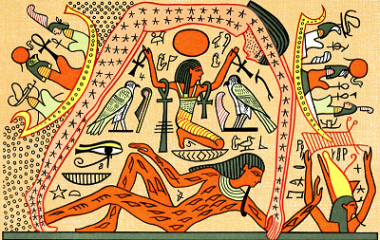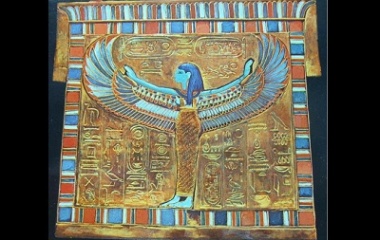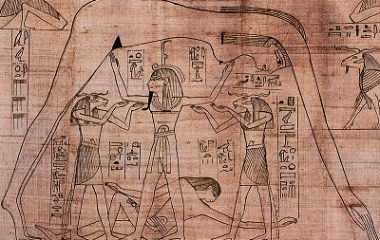- Pronunciation: new-eat
- Other names: Neuth, Nwt, Nuit and Newet
- Parents: Shu and Tefnut
- Powers: God of the sky
People of all cultures through the millennia have spent their nights looking up at the stars and wondering about their nature and purpose. Almost every culture has some sort of astrological tradition that plays an important role in their daily lives. For ancient Egyptians, the heavens above were the body of a great goddess by the name of Nut, and her story is a fascinating one.
Who Is Nut?
Nut was originally known as the goddess of the daytime sky, but over time she became associated with the sky as a whole. She was one of the oldest and most important goddesses in the Egyptian religion of the time.
She is seen as a great mother, having given birth to some of the most important gods of ancient Egyptian times. In a way, Nut reverses a common tradition in many cultures where the sky is associated with a male god, and the earth with a female one. In Egyptian mythology, the god of the earth is male, with Nut as his counterpart.
Nut was widely seen as a protector god and, since she had given birth so many times, as a motherly figure as well. She was a protector of the dead, and her special symbol was a ladder that was often painted inside the lid of coffins, so that she could protect the dead on their way to the afterlife.
Appearance
For the most part, Nut is simply represented as a human woman without any special or supernatural features. Sometimes her human form is embellished with wings, but this is more likely to be symbolic rather than literal.
She is commonly shown as a naked woman with a body covered in stars, bending over the earth. This symbolizes her as the night sky.
As with many Egyptian gods, she is also shown in non-human forms with symbolic importance. She can be shown as a great cow or as a sycamore tree. Sometimes, she is depicted as a great big sow, and the suckling piglets at her teats represent the many stars.
Family
Her parentage is of the highest order. Her father Shu is the god of the air. Her mother Tefnut is the goddess of moisture or water. Nut is therefore the product of air and water, which resulted in her being the goddess of the sky.
Some accounts say that she is the granddaughter of Atum and Ra, but another popular myth states that she is the mother of Ra.
She has a brother named Geb. Apart from being god of the Earth, Geb is also Nut’s husband.
Nut and Geb together produced Set, Osiris, Nepthys and Isis. Isis, in turn, gave birth to Horus. These divine children were the subject of intense devotion in Egypt and are some of the most important of all Egyptian gods.
There is some indication that she had a fifth child named Arueris who was also known as Horus the Elder.
Nut and Geb copulated and produced children until their father Shu came between them to stop this process under orders from Ra. This is why the air (Shu) lies between the sky (Nut) and the earth (Geb).
Origin and History
The story of Nut forms part of the creation myth of Heliopolis. This is the name of a city that is today recognized as being one of the most ancient Egyptian cities. Heliopolis served as a religious center for many Egyptian cults over the years. It was here that the main myths involving Nut and her family were written.
One of the main symbols of Nut is a ladder into the heavens known as a “maqet”. The story behind this ladder is a fascinating one, and is central to Egyptian mythology as a whole.
Her daughter Isis took the god Osiris as her husband. Osiris is also Isis’ brother, along with the god Set. Set murdered Osiris and cut his body into 14 pieces. Isis put Osiris back together and he then climbed a ladder into his mother for safety.
Nut seemed a very accommodating goddess, since it is not only Osiris who resides within her. Ra the sun god also travels through her every day in his chariot. Some myths say that she births Ra every morning in a continual cycle of resurrection.
It’s also thanks to a disagreement between Nut and Ra that the year is 365 days long. Ra was getting a little nervous about all the powerful gods that Nut was giving birth to, and as ruler of the gods, placed a ban on her. Specifically, he told Nut that she was not allowed to birth children on any day of the year.
This did not sit well with Nut, who went to the god of wisdom. This god, named Thoth, came up with a great idea. If Nut could not give birth on any of the 360 days of the year, they simply needed more days that were not part of that year. To do this, Thoth gambled for moonlight with the god of the moon and won enough times to create five extra days for the year. On these days, Nut could give birth to more children. It was because of this deception that Ra ordered Shu to separate Nut and Geb.
Egyptians considered these five days to be separate from the rest of the year, and traditionally celebrated them. Some of the five days were considered unlucky, while the days of Horus and Isis were thought of as being lucky.
In Modern Times
Although the religion of the ancient Egyptians is no longer practiced in any real way, we remain fascinated by the history and culture of ancient Egypt as one of the first truly large and complex civilizations. Modern spiritualists have also given new life to the myth of Nut and her heavenly companions, incorporating it into new-age practices. Thanks to the extensive writing and record keeping of ancient Egypt, it’s unlikely that we will ever forget about these characters.











When was this made
2017/2018